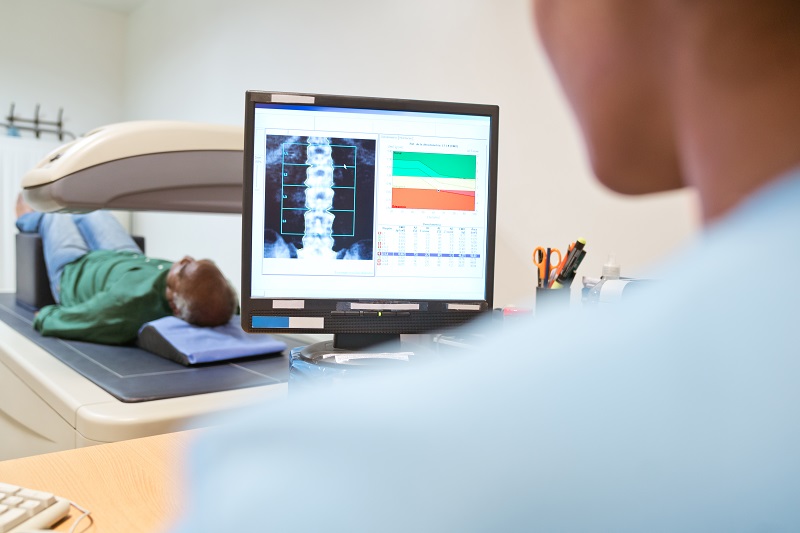How a Bone-Density Test Is Performed—and When You Should Get One

August 01, 2022
Unfortunately, osteoporosis often develops undetected, and the first sign of a problem is when a bone breaks. That’s why bone-density testing is recommended for higher-risk individuals:
- women age 65 and older, and
- women ages 50–64 who have risk factors such as a parent who has broken a hip, according to the U.S. Department of Health and Human Services.
“Bone-density tests are generally simple, painless and straightforward, and in a case where doctors are able to catch density loss early, they can make an enormous difference in a person’s long-term health,” says Nader Bakhos, M.D., orthopedic surgeon at Riverview Medical Center. “But providers are only able to make that catch if people take the time to get tested.”
How Tests Work
The most common form of a bone-density test works by scanning a person using X-ray technology to measure the presence of calcium and other minerals in the patient’s bones. Often called DEXA scans (short for Dual-energy X-ray absorptiometry), the tests are typically conducted in radiology offices. Here’s how it works:
- Patients lie on their backs on an elevated, padded table while a scanning machine passes over their hips and lower spine and a second X-ray device passes underneath.
- Patients must remain still during active scanning and may be asked to hold their breath for several seconds at a time.
- The entire process lasts about 15 minutes, and the radiation risk is about the same as from a typical X-ray, according to the U.S. Centers for Disease Control.
“DEXA scans focus on the hips and spine because those are the most likely locations for an injury related to a loss of bone density,” says Dr. Bakhos. “But other areas such as forearms, hands and feet also are at risk and can be assessed using a smaller, portable scanner.”
How Tests Are Scored
The test results are reported using a system called a T-score that compares a patient’s bone density to that of a healthy young adult. Scores often are reported as negative numbers, and higher numbers are better:
- 0: Patient matched the baseline “healthy young adult” standard
- -1 to 0: Patient considered healthy
- -2.5 to -1: Patient considered to have low bone mass
- Below -2.5: Patient considered to have osteoporosis
A second score, called a Z-score, shows the patient’s bone density compared to others of the same age, ethnicity and gender.
Regardless of whether someone thinks they may be affected by diminished bone density, if they are part of an at-risk group, the guidance is clear: Get tested.
Next Steps & Resources:
- Meet our source: Nader Bakhos, M.D.
- To make an appointment with Dr. Bakhos or an orthopedic specialist near you, call 800-822-8905 or visit our website.
- Learn about orthopedic care at Hackensack Meridian Health
The material provided through HealthU is intended to be used as general information only and should not replace the advice of your physician. Always consult your physician for individual care.
Find a doctor near me
Clinical Contributors
Should I Stop Cracking My Knuckles & Back?

Stop cracking your knuckles & back? Learn why from Drs. Katt & Lopez. Avoid joint pain; get expert advice. Call 800-822-8905.
Partial vs. Full Knee Replacements

Partial vs. Full Knee Replacements: Dr. Cahill explains the differences and helps you find the best knee surgery option. Call 800-822-8905 to learn more.
Find a doctor near me

Why Do Your Knees Hurt When You Squat?
Knee pain when squatting? Learn why from Dr. Russoniello and find relief. JFK University Medical Center offers expert care. Call 800-822-8905.

How to Relieve Knee Pain Triggered by Everyday Activities
It’s not just vigorous movements that can produce knee pain, but everyday activities as well.

